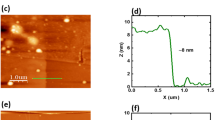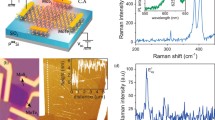Abstract
Construction of in-plane p-n junction with clear interface by using homogenous materials is an important issue in two-dimensional transistors, which have great potential in the applications of next-generation integrated circuit and optoelectronic devices. Hence, a controlled and facile method to achieve p-n interface is desired. Molybdenum sulfide (MoS2) has shown promising potential as an atomic-layer n-type semiconductor in electronics and optoelectronics. Here, we developed a facile and reliable approach to in-situ transform n-type MoS2 into p-type MoO3 to form lateral p-n junction via a KI/I2 solution-based chemical oxidization process. The lateral MoS2/MoO3 p-n junction exhibits a highly efficient photoresponse and ideal rectifying behavior, with a maximum external quantum efficiency of ∼650%, ∼3.6 mA W−1 at 0 V, and a light switching ratio of ∼102. The importance of the built in p-n junction with such a high performance is further confirmed by high resolution photo current mapping. Due to the high photoresponse at low source-drain voltage (VDS) and gate voltage (VG), the formed MoS2/MoO3 junction p-n diode shows potential applications in low-power operating photodevices and logic circuits. Our findings highlight the prospects of the local transformation of carrier type for high-performance MoS2-based electronics, optoelectronics and CMOS logic circuits.
摘要
由组成相同的材料构建具有清晰边界的平面内p-n异质结是 二维晶体管研究面临的主要挑战之一, 在下一代集成电路和光电 器件领域具有重要的潜在应用. 因此有必要开发一种可实现p-n界 面的简便、可控的操作方法. 硫化钼(MoS2)作为一种具有原子层 厚度的n型半导体材料已经在电子学和光电子学领域展现出巨大 的应用前景. 在本研究中, 我们通过KI/I2溶液化学氧化诱导方法实 现了从n型MoS2到p型MoO3的原位转化, 进而形成了横向面内p-n 异质结. MoS2/MoO3 p-n异质结显示出高效的光响应和整流特征, 0 V、~3.6mA W−1条件下最大外部量子产率达到~650%, 同时光开 关比达到~102. 构筑的p-n异质结的高性能也被光电流面扫描所证 实. 由于器件在低源漏电压(VDS)和栅压(VG)条件下具有高的光响 应性能, MoS2/MoO3 p-n二极管在光电器件及集成电路中的应用具 有低功耗的特点. 本研究为局部进行载流子种类转变提供了可能 的途径, 并将MoS2进一步应用于电子学、光电子学及CMOS逻辑 电路领域.
Similar content being viewed by others
References
Yoon Y, Ganapathi K, Salahuddin S. How good can monolayer MoS2 transistors be? Nano Lett, 2011, 11: 3768–3773
Zhou C, Wang X, Raju S, et al. Low voltage and high ON/OFF ratio field-effect transistors based on CVD MoS2 and ultra high-k gate dielectric PZT. Nanoscale, 2015, 7: 8695–8700
Chang HY, Yang S, Lee J, et al. High-performance, highly bendable MoS2 transistors with high-k dielectrics for flexible low-power systems. ACS Nano, 2013, 7: 5446–5452
Lu CC, Lin YC, Yeh CH, et al. High mobility flexible graphene field-effect transistors with self-healing gate dielectrics. ACS Nano, 2012, 6: 4469–4474
Liu Y, Guo J, Wu Y, et al. Pushing the performance limit of sub-100 nm molybdenum disulfide transistors. Nano Lett, 2016, 16: 6337–6342
Mustafeez W, Majumdar A, Vučković J, et al. A direct measurement of the electronic structure of Si nanocrystals and its effect on optoelectronic properties. J Appl Phys, 2014, 115: 103515
Liu Y, Ang KW. Monolithically integrated flexible black phosphorus complementary inverter circuits. ACS Nano, 2017, 11: 7416–7423
Britnell L, Gorbachev RV, Jalil R, et al. Field-effect tunneling transistor based on vertical graphene heterostructures. Science, 2012, 335: 947–950
Georgiou T, Jalil R, Belle BD, et al. Vertical field-effect transistor based on graphene-WS2 heterostructures for flexible and transparent electronics. Nat Nanotech, 2012, 8: 100–103
Yu WJ, Liu Y, Zhou H, et al. Highly efficient gate-tunable photocurrent generation in vertical heterostructures of layered materials. Nat Nanotech, 2013, 8: 952–958
Britnell L, Ribeiro RM, Eckmann A, et al. Strong light-matter interactions in heterostructures of atomically thin films. Science, 2013, 340: 1311–1314
Laskar MR, Nath DN, Ma L, et al. p-Type doping of MoS2 thin films using Nb. Appl Phys Lett, 2014, 104: 092104
Cuong NT, Otani M, Okada S. Gate-induced electron-state tuning of MoS2: first-principles calculations. J Phys-Condens Matter, 2014, 26: 135001
Chuang S, Battaglia C, Azcatl A, et al. MoS2 p-type transistors and diodes enabled by high work function MoOx contacts. Nano Lett, 2014, 14: 1337–1342
Zhang YJ, Ye JT, Yomogida Y, et al. Formation of a stable p-n junction in a liquid-gated MoS2 ambipolar transistor. Nano Lett, 2013, 13: 3023–3028
Zhao P, Kiriya D, Azcatl A, et al. Air stable p-doping of WSe2 by covalent functionalization. ACS Nano, 2014, 8: 10808–10814
Choi MS, Qu D, Lee D, et al. Lateral MoS2 p-n junction formed by chemical doping for use in high-performance optoelectronics. ACS Nano, 2014, 8: 9332–9340
Yu WJ, Li Z, Zhou H, et al. Vertically stacked multi-heterostructures of layered materials for logic transistors and complementary inverters. Nat Mater, 2013, 12: 246–252
Sup Choi M, Lee GH, Yu YJ, et al. Controlled charge trapping by molybdenum disulphide and graphene in ultrathin heterostructured memory devices. Nat Commun, 2013, 4: 1624–1631
Lim JY, Kim M, Jeong Y, et al. van der Waals junction field effect transistors with both n- and p-channel transition metal dichalcogenides. npj 2D Mater Appl, 2018, 2: 37
Zhang Z, Chen P, Duan X, et al. Robust epitaxial growth of two-dimensional heterostructures, multiheterostructures, and super-lattices. Science, 2017, 357: 788–792
Duan X, Wang C, Shaw JC, et al. Lateral epitaxial growth of two-dimensional layered semiconductor heterojunctions. Nat Nanotech, 2014, 9: 1024–1030
Fan X, Zhao Y, Zheng W, et al. Controllable growth and formation mechanisms of dislocated WS2 spirals. Nano Lett, 2018, 18: 3885–3892
Park GD, Choi SH, Kang YC. Electrochemical properties of ultrafine TiO2-doped MoO3 nanoplates prepared by one-pot flame spray pyrolysis. RSC Adv, 2014, 4: 17382–17386
Yin Z, Zhang X, Cai Y, et al. Preparation of MoS2-MoO3 hybrid nanomaterials for light-emitting diodes. Angew Chem Int Ed, 2014, 12560: 12565
Sharma RK, Reddy GB. Synthesis and characterization of a-MoO3 microspheres packed with nanoflakes. J Phys D-Appl Phys, 2014, 47: 065305
Seguin L, Figlarz M, Cavagnat R, et al. Infrared and Raman spectra of MoO3 molybdenum trioxides and MoO3·xH2O molybdenum trioxide hydrates. Spectrochim Acta Part A-Mol Biomol Spectr, 1995, 51: 1323–1344
Im H, Liu N, Bala A, et al. Large-area MoS2·MoOx heterojunction thin-film photodetectors with wide spectral range and enhanced photoresponse. APL Mater, 2019, 7: 061101
Gabette L, Segaud R, Fadloun S, Avale X, Besson P. Gold wet optimization on 200 mm substrates for MEMS application. ECS Trans, 2009, 25: 337–344
Sun S, Gao M, Lei G, et al. Visually monitoring the etching process of gold nanoparticles by KI/I2 at single-nanoparticle level using scattered-light dark-field microscopic imaging. Nano Res, 2016, 9: 1125–1134
Vattikuti SVP, Nagajyothi PC, Reddy PAK, et al. Tiny MoO3 nanocrystals self-assembled on folded molybdenum disulfide nanosheets via a hydrothermal method for supercapacitor. Mater Res Lett, 2018, 6: 432–441
Mestl G, Ruiz P, Delmon B, et al. Oxygen-exchange properties of MoO3: an in situ Raman spectroscopy study. J Phys Chem, 1994, 98:11269–11275
Li CQ, Shen X, Ding RC, et al. Controllable synthesis of one-dimensional MoO3/MoS2 hybrid composites with their enhanced efficient electromagnetic wave absorption properties. ChemPlusChem, 2019, 84: 226–232
Pareek A, Kim HG, Paik P, et al. Ultrathin MoS2-MoO3 nanosheets functionalized CdS photoanodes for effective charge transfer in photoelectrochemical (PEC) cells. J Mater Chem A, 2017, 5: 1541–1547
Luo W, Zhu M, Peng G, et al. Carrier modulation of ambipolar few-layer MoTe2 transistors by MgO surface charge transfer doping. Adv Funct Mater, 2018, 28: 1704539
Yoo G, Hong S, Heo J, et al. Enhanced photoresponsivity of multilayer MoS2 transistors using high work function MoOx overlayer. Appl Phys Lett, 2017, 110: 053112
Baugher BWH, Churchill HOH, Yang Y, et al. Optoelectronic devices based on electrically tunable p-n diodes in a monolayer dichalcogenide. Nat Nanotech, 2014, 9: 262–267
Patra KK, Ghosalya MK, Bajpai H, et al. Oxidative disproportionation of MoS2/GO to MoS2/MoO3−x/RGO: integrated and plasmonic 2D-multifunctional nanocomposites for solar hydrogen generation from near-infrared and visible regions. J Phys Chem C, 2019, 123: 21685–21693
Yu SH, Lee Y, Jang SK, et al. Dye-sensitized MoS2 photodetector with enhanced spectral photoresponse. ACS Nano, 2014, 8: 8285–8291
Zhang W, Huang JK, Chen CH, et al. High-gain phototransistors based on a CVD MoS2 monolayer. Adv Mater, 2013, 25: 3456–3461
Acknowledgements
We gratefully acknowledge the financial support from the National Natural Science Foundation of China (51722503, 51621004, 21705036 and 21975067), and the Natural Science Foundation of Hunan Province, China (2018JJ3035). The research has also received funding from the Fundamental Research Funds for the Central Universities from Hunan University.
Author information
Authors and Affiliations
Contributions
Duan H and Liu S conceived the ideas and designed the experiments; Bi K, Liu HW and Lin J engineered the samples; Wan Q, Shu Z and Shao G performed the XRD, XPS and Raman experiments. Bi K, Zhu M, Jin Y and Lin J fabricated and characterized the MoS2 device with assistance from Liu HW, Chen Y and Liu HZ. Bi K wrote the manuscript with input from all co-authors. All authors discussed the results and commented on the manuscript.
Corresponding authors
Additional information
Conflict of interest
The authors declare no competing financial interest.
Supplementary information
The schematic of device fabrication process, PL spectral change with time, photoresponses with different irradiation powers and the characterization of the control photoswitching of CVD MoS2 are available in the online version of the paper.
Kaixi Bi received his PhD majored in physics from Hunan University in 2019. He is now a fulltime lecturer at the School of Instrument and Electronics, North University of China. His current research interests include nanomanufacturing, low-dimensional material field effect transistors, smart micro/nanosystems and their relevant applications.
Song Liu received his PhD in 2011 from Peking University. He was a postdoctoral fellow working in Prof. Liming Dai’s group (2011-2013) in Case Western Reserve University. After three years’ research in National University of Singapore (2013-2016), he is now a full professor at the Institute of Chemical Biology and Nanomedicine, Hunan University. His research interests focus on the controlled synthesis of low-dimensional materials, the application research of functional devices and nanobiological research.
Huigao Duan received his BSc and PhD in physics from Lanzhou University (China) in 2004 and 2010, respectively. He joined Hunan University as a full professor in 2012 and then set up a micro/nanofabrication laboratory there. His current research interests include sub-10-nm patterning, high-resolution color printing, nanomanufacturing, smart micro/nanosystems and their relevant applications.
Rights and permissions
About this article
Cite this article
Bi, K., Wan, Q., Shu, Z. et al. High-performance lateral MoS2-MoO3 heterojunction phototransistor enabled by in-situ chemical-oxidation. Sci. China Mater. 63, 1076–1084 (2020). https://doi.org/10.1007/s40843-019-1259-6
Received:
Accepted:
Published:
Issue Date:
DOI: https://doi.org/10.1007/s40843-019-1259-6




